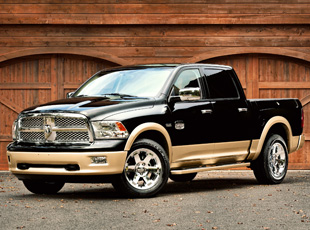Five Years Later, Chrysler’s Gamble on Ram Trucks Is Paying Off
On the factory floor itself, new, lean manufacturing methods transplanted from Fiat began revolutionizing the Warren plant’s operations — not only creating more efficient ways of building vehicles and increasing quality but also giving workers a stake in decision-making.
 In December, the sprawling, four million-square-foot factory here where workers assemble Ram pickup trucks, along conveyors that weave for more than 30 miles, suddenly went quiet.
In December, the sprawling, four million-square-foot factory here where workers assemble Ram pickup trucks, along conveyors that weave for more than 30 miles, suddenly went quiet.
Thousands of workers looked on where a makeshift stage, draped in black, had been assembled. Sergio Marchionne, Chrysler Group’s chairman and chief executive, stepped up to address the crowd.
In the dark days of Chrysler’s bankruptcy — when the company barely escaped extinction thanks to a taxpayer bailout and the purchase by Mr. Marchionne’s Fiat of a major stake, which later turned into ownership — such a staged display and work stoppage could have meant trouble. But not this time.
Mr. Marchionne was there to acknowledge an industry award for the truck, but, more important, to convey a simple message to the workers: well done.
“Today I wanted to come to Warren to personally thank all of you,” he said, and in his signature style joked about the criticism that followed his decision in 2009 to create the stand-alone Ram division. “The skeptics, who were already predicting our company was going down the tubes, thought for sure that we’d been smoking something funny.”
In 2009, when Ram was carved out from Dodge into a stand-alone division, it was a big gamble — and far from a sure thing. Some industry critics scoffed at the idea of a brand dedicated to pickup trucks. Others were puzzled: After the bailouts, the trend was to consolidate brands to streamline automakers’ offerings, but Chrysler was adding a new one.
Five years later, the verdict is in: The gamble paid off. Ram trucks have captured an ever-greater share of the full-size pickup market dominated in the past by General Motors and Ford, and are on track to seize even more. By adding innovative features not found in other pickups, and aggressive pricing to lure truck buyers, who are among the most loyal in the automotive business, Chrysler’s Ram has managed to go from also-ran to a threat in only a few years.
Here in Warren, the plant is now churning out Ram pickups 20 hours a day, six days a week, with occasional Sundays — barely able to keep up with demand.
In the fourth quarter of 2009, when the new Ram division’s trucks were hitting the streets, the company eked out a paltry 11 percent of the market share for full-size trucks. The two other Detroit automakers were lapping Chrysler around the track, with shares of 42 percent for G.M. and 37 percent for Ford. Since then Ram has conquered more and more of the market every year. In August, when sales surged 33 percent over a year earlier, Ram commanded 21 percent of full-size pickup purchases in the United States.
Most of that success has come at the expense of G.M.’s Chevrolet Silverado pickup, which despite its own recent redesign has lost market share this year. Ford’s F-Series pickups remain the overall market leader, but their sales have also dipped this summer as the automaker prepares to introduce a new generation of trucks made with an aluminum body.
Reid Bigland, Chrysler’s head of United States sales and head of the Ram division from April 2013 to last month, said that what made the new division different was an intense focus on pickups, which under the Dodge umbrella and its muscle-car heritage had never quite received their due.
“Selling trucks is just a different business than cars,” Mr. Bigland said, “and we had a group of people who could come to work and do nothing but think about pickup trucks.”
One result was features competitors did not have, like air suspensions, cargo cameras, eight-speed transmissions and, last year, a diesel engine that gets 28 miles a gallon on the highway.
On the factory floor itself, new, lean manufacturing methods transplanted from Fiat began revolutionizing the Warren plant’s operations — not only creating more efficient ways of building vehicles and increasing quality but also giving workers a stake in decision-making.
“The floor has a voice now,” said Tracie Fern, a Warren worker who helps find ways to make jobs on the assembly line more efficient. “When someone has a suggestion, they listen to us.”
Go back to the 1980s, and the Dodge Ram was not even an also-ran. “It was just a blip on the radar back then,” said Karl Brauer, senior analyst with Kelley Blue Book. “Ford and Chevy didn’t think about, or care about, what Ram was doing.”
The first real attention-grabber was the 1994 Ram, which featured the aggressive, curved “big rig” look the Ram still incorporates today. But while the muscular design change drew attention and increased sales, the truck languished in a distant third.
When the stand-alone experiment began in 2009, the near-death experience of the bankruptcy and taxpayer bailout had left its mark on Chrysler. Ram executives said they knew they would have to deliver results, and quickly.
“You either come out swinging or you roll over,” said Robert Hegbloom, a Ram executive who last month became head of the brand. (Mr. Bigland was tapped to lead Fiat’s Alfa Romeo unit in North America.)
A conference room in the basement of Chrysler’s headquarters was turned into a makeshift “Ram war room.” The new team members gathered regularly to brainstorm ideas, figure out ways for the trucks to distinguish themselves, and perhaps most important, zero in on what truck buyers wanted.
Mr. Marchionne, well known for his blunt style and attention to detail, held monthly meetings with the Ram executives, where he expected updates.
For light-duty pickups, the team decided to hone in on a priority they were hearing from truck customers. “It was all about fuel economy,” Mr. Hegbloom said, explaining that buyers used to willingly sacrifice gas mileage for hauling capability. Now they wanted both.
Ram engineers went to work, and by adding a host of features — shutters that close the front grille at high speeds to reduce drag, an eight-speed transmission and ultimately a new turbodiesel engine — they managed to increase the trucks’ hauling performance while also topping the charts on fuel economy.
Designers also focused on upgrading the interiors. That was because the nature of pickup trucks was changing. A pickup used to be a bare-bones affair: Bench seats were common, back seats generally nonexistent. Now, so-called crew cabs are ubiquitous, and the comfort and technology match those of any sport utility vehicle.
“They’re really a lot like luxury vehicles these days,” said Jessica Caldwell, senior analyst with Edmunds.com.
Jeff Jagoda, a fourth-generation autoworker, now at the Ram factory in Warren, has seen the evolution firsthand. He bought his first truck in 1975, and with its crank windows, bench seat and exposed steel inside, he said the last word to describe it would be luxury. “When I brought it home my mother said: ‘What are you doing with this thing? You’re not a farmer,’ ” he said. “But that’s what trucks used to be, something people bought to get work done, nothing more. Today, they’re something else entirely; you’ve got all the comforts of home if you want.”
Sean Kilmain, who lives on Cape Cod in Massachusetts, bought his new Ram 1500 in July after test-driving Ford and G.M. trucks. He said he wanted something that could be comfortable for family skiing trips to Vermont but also capable of towing his boat or hauling gear.
“When you’re looking to take two dogs and your nephews along for the ride, space becomes an issue,” Mr. Kilmain said. “This will be the truck that we take places.” What sold him on the Ram, he said, was that he felt the truck offered more features for less money than the competition, and that the fuel economy was also impressive.
“I didn’t want to get a gas guzzler, but also wanted something that could do pretty much anything I wanted,” he said. “Haul some stuff, carry some people.”
Mr. Brauer, the Kelley Blue Book analyst, predicted that Ram might give G.M. a run for its money, and could possibly seize the No. 2 spot in coming years — something that would have been unthinkable a decade ago.
“Ford is just a monster in the pickup category, and always will be. But what we could see is a Ford main show, with G.M. and Ram left to fight it out,” he said. “If that’s the case, then Ram is winning.”
Source: nytimes.com

 News, training, experts opinion, bibliography, software and everything about Lean world.
News, training, experts opinion, bibliography, software and everything about Lean world.
